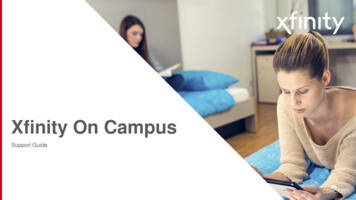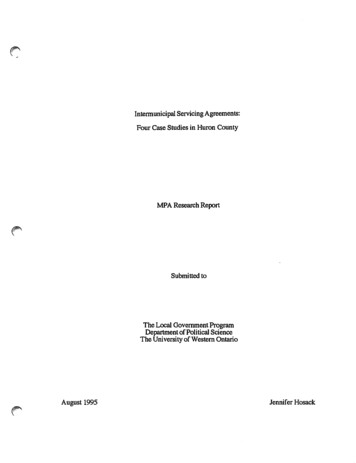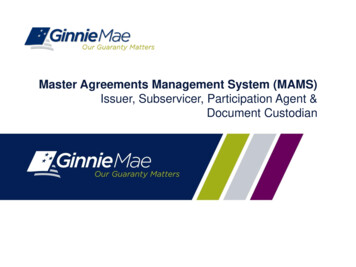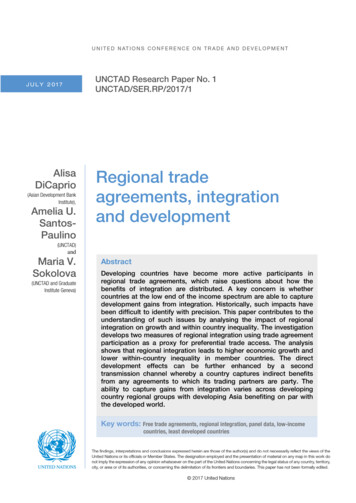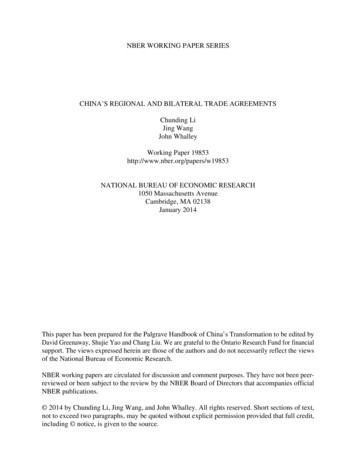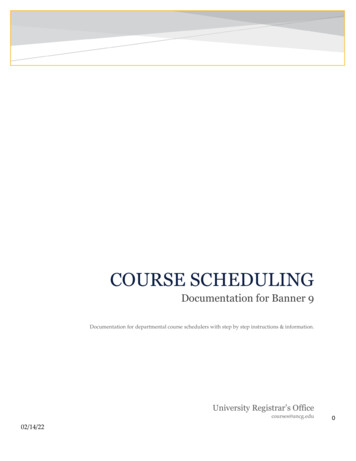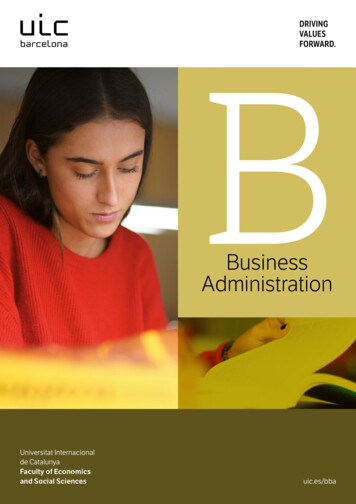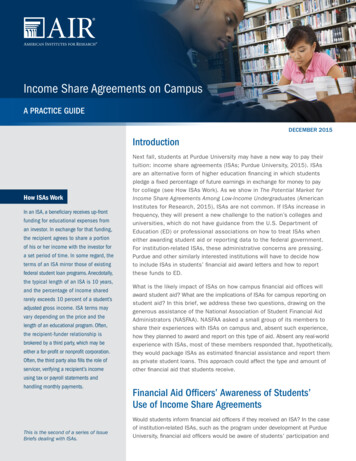
Transcription
Income Share Agreements on CampusA PRACTICE GUIDEDECEMBER 2015IntroductionHow ISAs WorkIn an ISA, a beneficiary receives up-frontfunding for educational expenses froman investor. In exchange for that funding,the recipient agrees to share a portionof his or her income with the investor fora set period of time. In some regard, theterms of an ISA mirror those of existingfederal student loan programs. Anecdotally,the typical length of an ISA is 10 years,and the percentage of income sharedrarely exceeds 10 percent of a student’sadjusted gross income. ISA terms mayvary depending on the price and thelength of an educational program. Often,the recipient-funder relationship isbrokered by a third party, which may beeither a for-profit or nonprofit corporation.Often, the third party also fills the role ofservicer, verifying a recipient’s incomeusing tax or payroll statements andhandling monthly payments.This is the second of a series of IssueBriefs dealing with ISAs.Next fall, students at Purdue University may have a new way to pay theirtuition: income share agreements (ISAs; Purdue University, 2015). ISAsare an alternative form of higher education financing in which studentspledge a fixed percentage of future earnings in exchange for money to payfor college (see How ISAs Work). As we show in The Potential Market forIncome Share Agreements Among Low-Income Undergraduates (AmericanInstitutes for Research, 2015), ISAs are not common. If ISAs increase infrequency, they will present a new challenge to the nation’s colleges anduniversities, which do not have guidance from the U.S. Department ofEducation (ED) or professional associations on how to treat ISAs wheneither awarding student aid or reporting data to the federal government.For institution-related ISAs, these administrative concerns are pressing.Purdue and other similarly interested institutions will have to decide howto include ISAs in students’ financial aid award letters and how to reportthese funds to ED.What is the likely impact of ISAs on how campus financial aid offices willaward student aid? What are the implications of ISAs for campus reporting onstudent aid? In this brief, we address these two questions, drawing on thegenerous assistance of the National Association of Student Financial AidAdministrators (NASFAA). NASFAA asked a small group of its members toshare their experiences with ISAs on campus and, absent such experience,how they planned to award and report on this type of aid. Absent any real-worldexperience with ISAs, most of these members responded that, hypothetically,they would package ISAs as estimated financial assistance and report themas private student loans. This approach could affect the type and amount ofother financial aid that students receive.Financial Aid Officers’ Awareness of Students’Use of Income Share AgreementsWould students inform financial aid officers if they received an ISA? In the caseof institution-related ISAs, such as the program under development at PurdueUniversity, financial aid officers would be aware of students’ participation and
may even be responsible for disbursing the funds. Whether financial aid officerswould have the same knowledge of independent ISAs is far from clear. Onefinancial aid officer raised the following concern:[T]here’s still such a thing as private loans that don’t require schoolcertification. I imagine that ISAs can easily keep the financial aid officeout of the loop. And that’s a potential problem for the provider becausethey might not be knowledgeable enough to know how to determine whatthe student really needs. The potential could be there for a student whohas aid to still go to the ISA provider for funding up to the full [costof attendance].No reliable mechanisms exist for campus professionals to learn whether astudent is using an ISA. Although the vast majority of private education loansrequire school certification (Consumer Financial Protection Bureau, 2012), nosuch requirement exists for ISAs. Similarly, no financial aid officer we spoke withidentified a clear and consistent way in which students were asked to reportISAs to institutions. Finally, neither the Free Application for Federal StudentAid (FAFSA) nor the CSS/Profile contains questions that specifically elicitinformation about ISAs from students or parents.1 School certification, alreadyunderstood by most financial aid officers, appears to be the simplest solution.Several institution-related ISAs are working to incorporate school certificationinto the origination and verification process and address these problems.Absent a consistent process, two problems arise. First, institutional compliancewith federal rules governing aid packaging—and the wise use of financial aidfunds—is substantially complicated when financial aid officers are not awareof all the ways in which a student is financing his or her education. Equally asproblematic is the challenge this presents to financial aid officers who wouldotherwise facilitate conversations with students and families about how tounderstand an ISA relative to a grant or an education loan. Consequently,students risk making poor financial decisions, diminishing the very benefitthis innovation in student aid seeks to offer.Income Share Agreements and Aid PackagingEven when financial aid officers are aware that a student has an ISA, this maypose challenges for financial aid packaging (i.e., the process of awarding aidto meet a student’s financial need). According to ED,Packaging is a process that varies from school to school, depending onthe types of scholarship and other aid available at the school, and thecharacteristics of the student population. Schools may have differentpackaging philosophies, but they generally try to find the best combinationof aid to meet the financial need of the students they serve. (FederalStudent Aid, 2015, page 3-137)Federal regulations prevent financial aid officers from awarding students morethan they need to cover the cost of attendance (COA; i.e., tuition, room, andboard). The regulations also specify the order in which different types of aid2Income Share Agreements on CampusA PRACTICE GUIDE
should be awarded, but none of these regulations mention ISAs. Thisuncertainty places financial aid officers in the difficult position of determininghow to prioritize ISA funds when packaging several types of financial aid.Based on early conversations with experts in federal student aid policy, includingcampus aid professionals, policy advocates, and financial services providers,it appears likely that ISAs will be factored into aid packaging as functionallyequivalent to a private student loan, not adjusted available income.One U.S. Department of Education official with whom we spoke statedthe following:Based on early conversations withexperts in federal student aid policy,including campus aid professionals,policy advocates, and financialservices providers, it appears likelythat ISAs will be factored into aidpackaging as functionally equivalentto a private student loan, not adjusted[B]ased on the information we have today, we would consider paymentsthrough ISAs to be “estimated financial assistance” that would affectstudents’ eligibility for all Title IV aid besides Pell Grants. In general, wetreat a resource as estimated financial assistance if it is only receivedbecause the student is enrolled in a postsecondary program, but it isnot a form of employment. ISAs appear to meet those criteria.available income.According to the 2015–2016 Federal Student Aid Handbook, estimatedfinancial assistance (EFA) is aid that a student receives from the institution(or an individual outside the institution) because the student is enrolled in apostsecondary program (Federal Student Aid, 2015). Examples of EFA includescholarships, federal Direct Loans, PLUS loans, Federal Work Study (FWS), andprivate loans. When packaging student aid, a financial aid officer will first lookat a student’s expected family contribution (EFC) to determine whether thestudent is eligible for a Pell Grant and then package EFA (Federal Student Aid,2015). Institutions have some discretion in how they prioritize different typesof EFA during packaging, such as prioritizing students with greater need.If ISAs were considered EFA, they would not affect students’ eligibility forPell Grants or Iraq and Afghanistan Service Grants. However, ISAs could beconsidered when awarding other forms of need-based aid, such as FWS andDirect Subsidized (need-based) Loans (Federal Student Aid, 2015). In addition,ISAs could have an impact on non-need-based aid. Where a student’s COA islarger than the annual Direct Unsubsidized (not need based) Loan maximum,an ISA could replace other sources of borrowing, such as PLUS loans orprivate loans.The effect of an ISA on EFA depends on the ISA’s size and a student’s COA.For example, imagine a third-year undergraduate student, Carl, qualifies fora Pell grant, a Subsidized Direct loan, and an Unsubsidized Direct loan. If Carlreceives a 5,000 ISA, his Unsubsidized Direct loan amount will change sothat his aid package does not exceed his total costs (Table 1).3Income Share Agreements on CampusA PRACTICE GUIDE
Table 1. Carl’s Financial Aid Package: Scenario 1Before ISAAfter ISA 15,500 15,500Pell Grant 4,825 4,825Direct Subsidized Loan 5,500 5,500 0 5,000COAISADirect Unsubsidized LoanUnmet COAb 2,000 3,175 175a 0aSchools are allowed to process Direct Loan amounts less than 200, although they are not requiredto do so.bUnmet COA is a calculation of the difference between a student’s costs and financial resources. Itdoes not include EFC, which is an index used to determine a student’s eligibility for need-basedfinancial aid, such as Pell Grants. However, EFC is not the amount of money that a family must pay.In this scenario, Carl’s ISA funds help him cover 3,175 of his unmet COA.However, it also replaces most of his Unsubsidized Direct Loan. By acceptingthe ISA, Carl loses access to a federal student loan with generous repaymentterms, such as a six-month grace period after leaving school and the option toenroll in income-driven loan repayment.If Carl receives a larger ISA, it also could replace some of his need-based aid.In this scenario, Carl would still receive a Pell Grant, but the ISA would replaceboth types of direct loans because a student whose total financial aid exceedshis or her COA cannot receive any federal financial aid from programs offeredunder Title IV of the Higher Education Act, with the exception of a Pell Grant(Table 2).Table 2. Carl’s Financial Aid Package: Scenario 2Before ISAAfter ISA 15,500 15,500Pell Grant 4,825 4,825Direct Subsidized Loan 5,500 0 0 15,000 2,000 0COAISADirect Unsubsidized LoanUnmet COAa 3,175- 4,325a (surplus)When adjusting for an ISA, a financial aid officer cannot decrease the Pell Grant amount because PellGrants are considered entitlements. A student can exceed COA with only Pell Grants and other nonTitle IV forms of estimated financial assistance, such as an ISA.Before receiving an ISA, Carl needs to find 3,175 to pay for his college costs.But if he uses an ISA, his total COA is met, and he has money left over fromthe Pell Grant. His federal loans have been eliminated because an ISA isadded to his financial aid package.Having 4,325 in additional funds should not be Carl’s sole reason for choosingan ISA in this second scenario. If he plans to earn a lot after college, an ISAcould cost him more in the long run. For example, if his starting salary is 35,000 per year after graduation and he has to pay 10 percent of his4Income Share Agreements on CampusA PRACTICE GUIDE
earnings for 15 years, the repayment would be 49,525, even starting withan extra 4,325 in the bank. (This estimation is based on the median incomeafter college and 5 percent annual growth in income, ending at 69,300 after15 years.) On the other hand, if Carl prefers not to take on any student loandebt, then an ISA would an attractive alternative. Carl would benefit fromguidance from a financial aid officer, who could help him understand thesetrade-offs.Ultimately, federal policymakers will determine how campus financial aidofficers are to treat the financial support ISAs offer their recipients. Until thatguidance arrives, however, aid administrators will be left to wonder about anISA’s implications for awarding financial assistance. For institutions that areactively exploring ISAs, such as Purdue University (2015), this issue willhave to be addressed soon.Income Share Agreements and Campus Reportingon Student AidIf ISAs grow in frequency, institutional research and financial aid offices alsowould be expected to report to federal authorities on ISAs. On this issue, aswith award processing, guidance has not yet been received from ED. As moreISAs are used to meet education expenses, the extent of students’ financialobligations after graduating from college will be underreported.One of the principal reporting requirements for institutions participating inprograms authorized under Title IV of the Higher Education Act is to theIntegrated Postsecondary Education Data System (IPEDS). Institutions,typically through their institutional research offices, are to report through theIPEDS Student Financial Aid component on the award of federal, state,institutional, and private aid (National Center for Education Statistics, 2015).The Student Financial Aid component of IPEDS itself contains no reportinginstructions on the treatment of ISAs, and neither do key supporting materials,such as the IPEDS glossary and training materials, that campuses use tocomplete IPEDS surveys (Association for Institutional Research, 2014).Institution-related ISAs that follow a school certification process and developprocesses to collect data on recipients will be able to report student totals,aggregate funds received, and average award amounts. If other ISAs arereported at all—again, it is hard to report something the financial aid officeknows nothing of—most aid administrators reported they would include ISAsin their accounting of private student loans. Although most acknowledge theseproducts are not loans, the alternative is to report them as private grants.However, because Federal Student Aid training materials currently specifythat private grants include only those funds disbursed through the financial aidoffice, this reporting avenue appears closed for ISAs that are not institutionrelated with a campus-based certification and payment process (Associationfor Institutional Research, 2014).5Income Share Agreements on CampusA PRACTICE GUIDE
IPEDS is far from the only reporting requirement placed on Title IV-participatinginstitutions. These institutions also must meet a range of other FederalStudent Aid reporting requirements, including documentation of student loancounseling and lists of preferred private lenders. These reporting requirementsare not poised to accommodate the potential growth in ISAs. The 2015–2016Federal Student Aid Handbook, which weighs in at a voluminous 1,299 pages,does not contain a single reference to ISAs. Federal student aid trainingresources (Federal Student Aid, n.d.b) and Dear Colleague Letters (FederalStudent Aid, n.d.a) also make no mention of ISAs.As ISAs become more common, the lack of clear reporting requirementswill have repercussions on the quality of data that informs policymaking,accountability, research, and consumer information. Students, administrators,and the public will be unable to discern how many students receive ISAs (andthe terms of these agreements), and comingling reporting on ISAs with that ofother forms of aid, such as private loans, makes existing data about thoseproducts less useful. Additional qualitative data, such as the names of ISAfunders who have developed partnerships with an institution, also couldbenefit students, aid administrators, and regulators.ConclusionFinancial aid administrators navigate uncharted waters when studentsreceive ISAs. Without clear guidance or standards for processing thesefunds or reporting them to ED, administrators have no choice but to usetheir best judgment. At best, this situation leads to inconsistency. At worst,students could take large financial risks with insufficient information, andadministrators could be held responsible for inaccurate federal reporting.As ISAs become more common, thelack of clear reporting requirementswill have repercussions on the qualityof data that informs policymaking,accountability, research, andconsumer information.Our preliminary exploration indicates that many financial aid administratorswould likely package and report ISAs as if they were private student loans.Because ISAs require financial aid administrators to create nonroutineprocedures for award packaging and data reporting, institutions shouldinclude financial aid officers when developing and implementing ISAs oncampus. It is equally important for financial aid offices to have a seat atthe table when an institution considers partnering with an external firm tooffer ISAs. Collaboration across different offices within the institution willfacilitate better planning and implementation.How might uncertainty be resolved? Student aid administration is guidedby statute, by regulation, by subregulatory guidance offered by ED throughDear Colleague Letters (Federal Student Aid, n.d.a), and through instructionsand training offered in Federal Student Aid publications, such as the FederalStudent Aid Handbook (Federal Student Aid, 2015). As of December 2015,ISAs were not addressed in statute, regulation, subregulatory guidance,or instructional materials, and ED did not have plans in place to developguidance. As one ED official noted, “We have not seen enough actualexamples of ISAs at work, and because we have not yet received the questionfrom the field, we have no immediate plans to publish guidance on this topic.”6Income Share Agreements on CampusA PRACTICE GUIDE
Although only ED can provide authoritative guidance about the treatment ofISAs under federal student aid methodology, the financial aid communitycan help identify what its most experienced and knowledgeable membersare doing to incorporate ISAs into the administration of aid. The financialaid community should share these experiences and best practices with EDas well as the Consumer Financial Protection Bureau. This collaborationwould help ensure that the federal government has the knowledge baseneeded to monitor and provide guidance to the field regarding ISAs.Endnote1.However, students may include ISA funds as money paid on the student’s behalf(question 45j on the paper version of the FAFSA). This could be prevented bychanging “someone” to “a friend or a relative (not a parent or funder).”See ved.htm for moreinformation.ReferencesAmerican Institutes for Research. (2015). The potential market for income shareagreements among low-income undergraduates: An issue brief for policymakersand advocates. Washington, DC: Author. Retrieved from Low-Income-Undergraduates-Sept-2015.pdfAssociation for Institutional Research. (2014). Types of financial aid tutorial script:2014–15 data collection cycle. Tallahassee, FL: Author. Retrieved al-Aid.pdfConsumer Financial Protection Bureau. (2012). Private student loans. Washington,DC: U.S. Department of Education, Consumer Financial Protection Bureau.Retrieved from http://files.consumerfinance.gov/f/201207 cfpb ReportsPrivate-Student-Loans.pdfFederal Student Aid. (2015). Packaging aid. In Federal student aid handbook,2015–2016. Washington, DC: U.S. Department of Education, FederalStudent Aid. Retrieved from HbkVol3Ch7.pdfFederal Student Aid. (n.d.a). iLibrary—dear colleague letters. Washington, DC: U.S.Department of Education, Federal Student Aid. Retrieved from https://www.ifap.ed.gov/ifap/byYear.jsp?type dpclettersFederal Student Aid. (n.d.b). Training. Washington, DC: U.S. Department ofEducation, Federal Student Aid. Retrieved from onal Center for Education Statistics. (2015). IPEDS 2015–16 data collectionsystem. Washington, DC: Author. Retrieved from package 7 16.pdfPurdue University. (2015, November 23), Purdue Research Foundation signs letterof intent to explore college funding alternative [Press release]. Retrieved e Share Agreements on CampusA PRACTICE GUIDE
This Issue Brief is part of an ongoing series of products supported financially bythe Bill & Melinda Gates Foundation. The views and conclusions expressed hereinare those of the authors and do not express the viewpoint of the foundation. Weare deeply indebted to Mandy Sponholtz from the National Association of StudentFinancial Aid Administrators (NASFAA) for her help in contacting financial aidadministrators and her feedback on early drafts of this brief. Any errors are ourown. Direct inquiries to Matthew Soldner at 1000 Thomas Jefferson Street NW,Washington, DC 20007, or msoldner@air.org.About American Institutes for Research1000 Thomas Jefferson Street NWWashington, DC 20007-3835202.403.5000www.air.orgEstablished in 1946, American Institutes for Research (AIR) is an independent,nonpartisan, not-for-profit organization that conducts behavioral and social scienceresearch on important social issues and delivers technical assistance, both domesticallyand internationally, in the areas of education, health, and workforce productivity.4073 12/15
According to the 2015-2016 Federal Student Aid Handbook, estimated financial assistance (EFA) is aid that a student receives from the institution . Carl loses access to a federal student loan with generous repayment terms, such as a six-month grace period after leaving school and the option to enroll in income-driven loan repayment.



